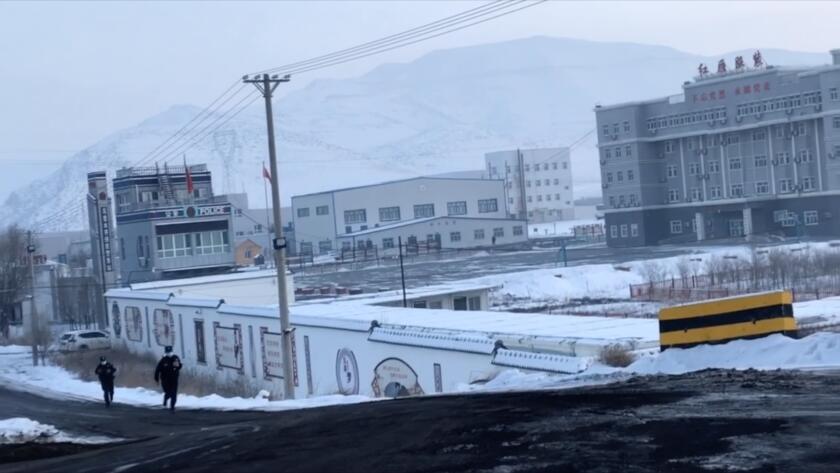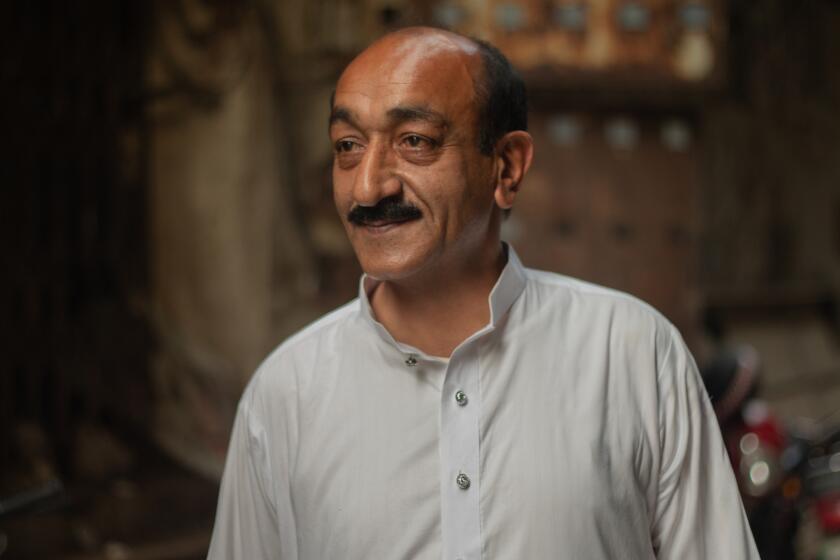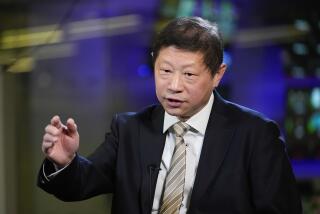
- Share via
ÜRÜMQI, China — The car drove toward a site visible by satellite but not marked on Chinese maps. It lay hidden in the mountains along a desolate road lined with Islamic cemeteries. The car traveled south as a red sun sank over snow-blanketed peaks, turning tombstones to silhouettes.
Night was coming to Xinjiang. The car approached a police tower guarding the Hongyan Clothing Park compound. A slogan appeared on the building’s walls: “Forget not the Party’s mercy, walk with the Party forever.” In an instant, police and men in dark clothing sprinted toward the car, surrounding the reporters inside.
“Delete everything,” one of the men ordered. The reporters complied and left, only to be stopped twice more by cars that swerved in front and beside them, letting out minders who demanded double-checks of the journalists’ phones and cameras.
- Share via
Police run to stop The Times from filming a suspected former internment site near Ürümqi in China’s northwestern Xinjiang region on Dec. 8, 2020. Many detention sites have now been converted into labor facilities.
This was territory Chinese authorities did not want the outside world to see: evidence against President Xi Jinping’s claims of bringing mass “happiness” to the northwestern region of Xinjiang, where a vast system of surveillance, detention, cultural erasure and forced labor has devastated the Uighur people in their homeland.
On a recent weeklong trip across Xinjiang, a Times reporter and a colleague working for a German outlet visited more than a dozen prisons, detention centers, demolished mosque sites and former reeducation camps turned into high-security factories. The Times met with Uighurs — they are predominately Muslim — who spoke of their imprisonment, fear and life in the region.
The Chinese government’s tactics in Xinjiang are the culmination of tensions that have simmered since the Mao era, when the state sponsored a massive influx of Han Chinese settlers. The repression that followed led to deadly riots and Uighur attacks on police and civilians, some of which were claimed by a separatist movement.
In 2017, the Chinese government forced more than a million Uighurs, Kazakhs and other ethnic minorities into indoctrination camps in what authorities described as a “counterterrorism” strategy. But many swept into that system had no ties to extremist or separatist groups.
They reached their hands into my family, strangled us and wouldn’t let us go.
— Jevlan Shermemet, a Uighur
Jevlan Shirmemmet, 29, a Uighur who left China as a student in 2011 and is now a tour guide in Istanbul, lost contact with his parents and brother when they were taken to the camps in 2018. Only in June this year did he hear from his father, who called from a police station. His first sentence after two years was not a greeting, but an accusation that his son had joined “troublesome groups” abroad. Shirmemmet was shocked.
He hadn’t joined any political movements, he told his father. “This was my father’s mouth,” Shirmemmet said, “but it was the Xinjiang authorities and public security speaking through him.”
His mother, he was told, had been sent to prison — probably because she visited him in Turkey in 2013. When Shirmemmet asked the Chinese Embassy in Turkey for proof of her trial or conviction, they suggested he instead write a list of his activities and contacts abroad. “If you can figure out where you did wrong, tell us,” an embassy official told him.
Shirmemmet’s parents were civil servants who taught him to speak fluent Mandarin and avoid politics. But being Uighur, he said, made him a target for the Communist Party. “They reached their hands into my family, strangled us and wouldn’t let us go,” he said of the party. “As long as you are Uighur, you are political.”
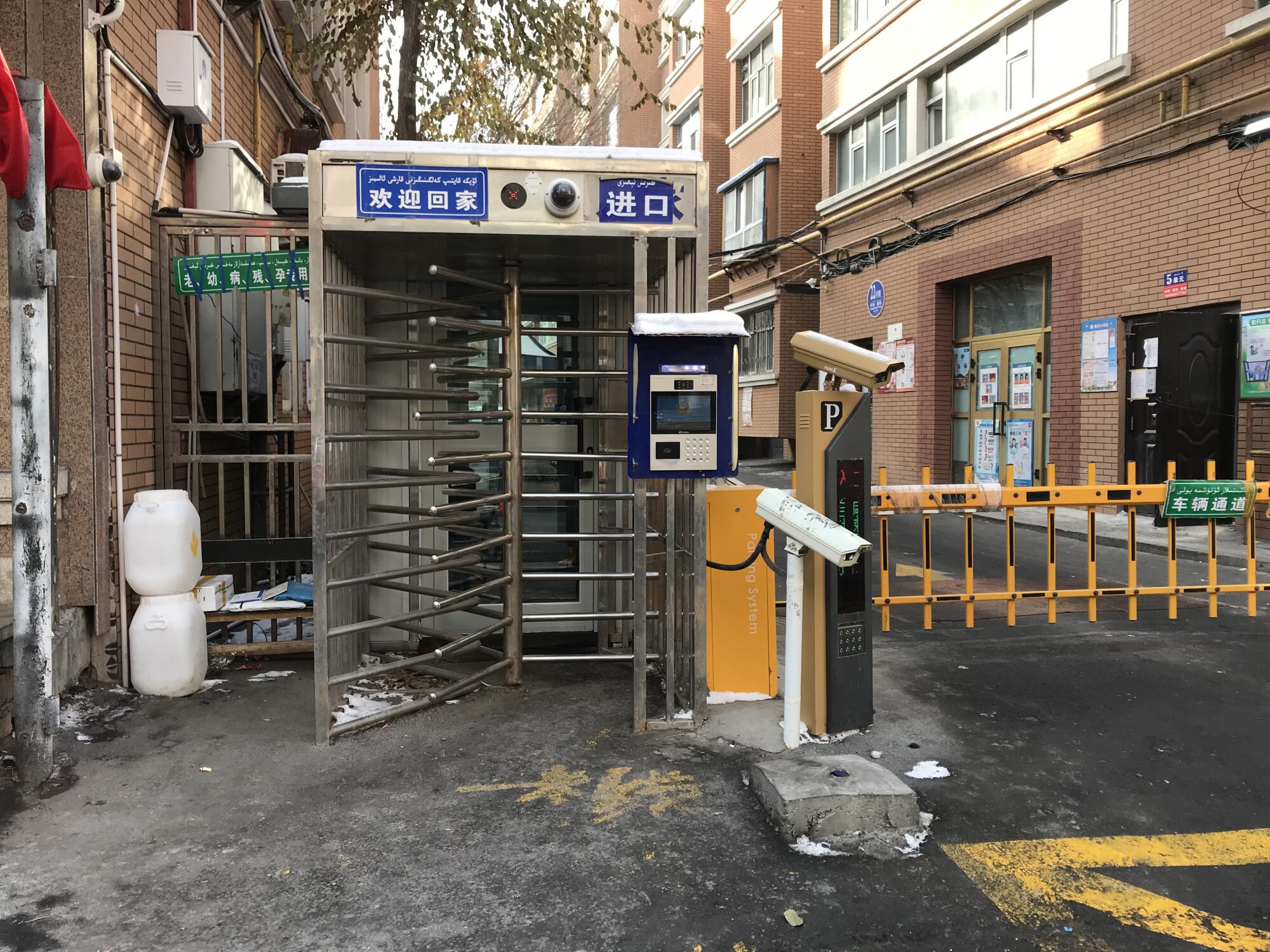
In Xinjiang today, cameras hang over every street and inside every taxi, sending footage to the police. Residential compounds are watched by facial recognition systems, security guards, and pandemic QR codes that are scanned at every entry or exit. Police in flak jackets stand at bus stops, stores and ubiquitous “convenience stations” that often have large portraits of Xi surrounded by happy children, smiling through the windows.
Whatever technology misses, humans report. Inside a Uighur store near Ürümqi’s grand bazaar, a document on the wall listed 10 Uighur names and phone numbers linking nearby stores together, along with instructions to spread party doctrine, watch for outsiders and monitor acts threatening “social stability.” In a village on the outskirts of Kashgar, posters announced an upcoming disciplinary inspection of local cadres and welcomed villagers to report any suspicious behavior of the cadres.
Several Uighur villages the reporters visited near Kashgar and Korla appeared empty. Signs were posted on doors stating that the locks had been changed because residents had been absent for too long. Murals portrayed Uighur women bursting out of black veils into colorful clothing and a giant ax chopping Uighurs holding an East Turkestan flag — a symbol for Xinjiang independence — into pieces.
We’ve had too many negative reports from outside. You can only speak with the people we arrange.
— Chinese official
Every day, the two reporters were summoned off trains and planes upon arrival. They were registered, photographed and given coronavirus tests by police. Their car was tailed by several vehicles and men who sometimes called police to stop them. At times, the men manhandled the journalists.
During one confrontation in a village outside Korla, an official blurted: “You can’t speak with the people here. We’ve had too many negative reports from outside. You can only speak with the people we arrange.” Talking to locals would create a “security problem,” he said.
What the minders preferred to present of Xinjiang was an illusion of normalcy: Uighurs mingled with Han Chinese at the night market in Kashgar. They invited shoppers to eat samples at a naan museum in Ürümqi. They sang about ethnic unity and “never splitting apart” in slick music videos played at tourist sites.
In Korla, minders led reporters to a plaza to watch dozens of mostly Han Chinese middle-aged residents wearing Uighur costumes, dancing to a Uighur song. “Aren’t these uncles and aunties cute?” one of the minders said.
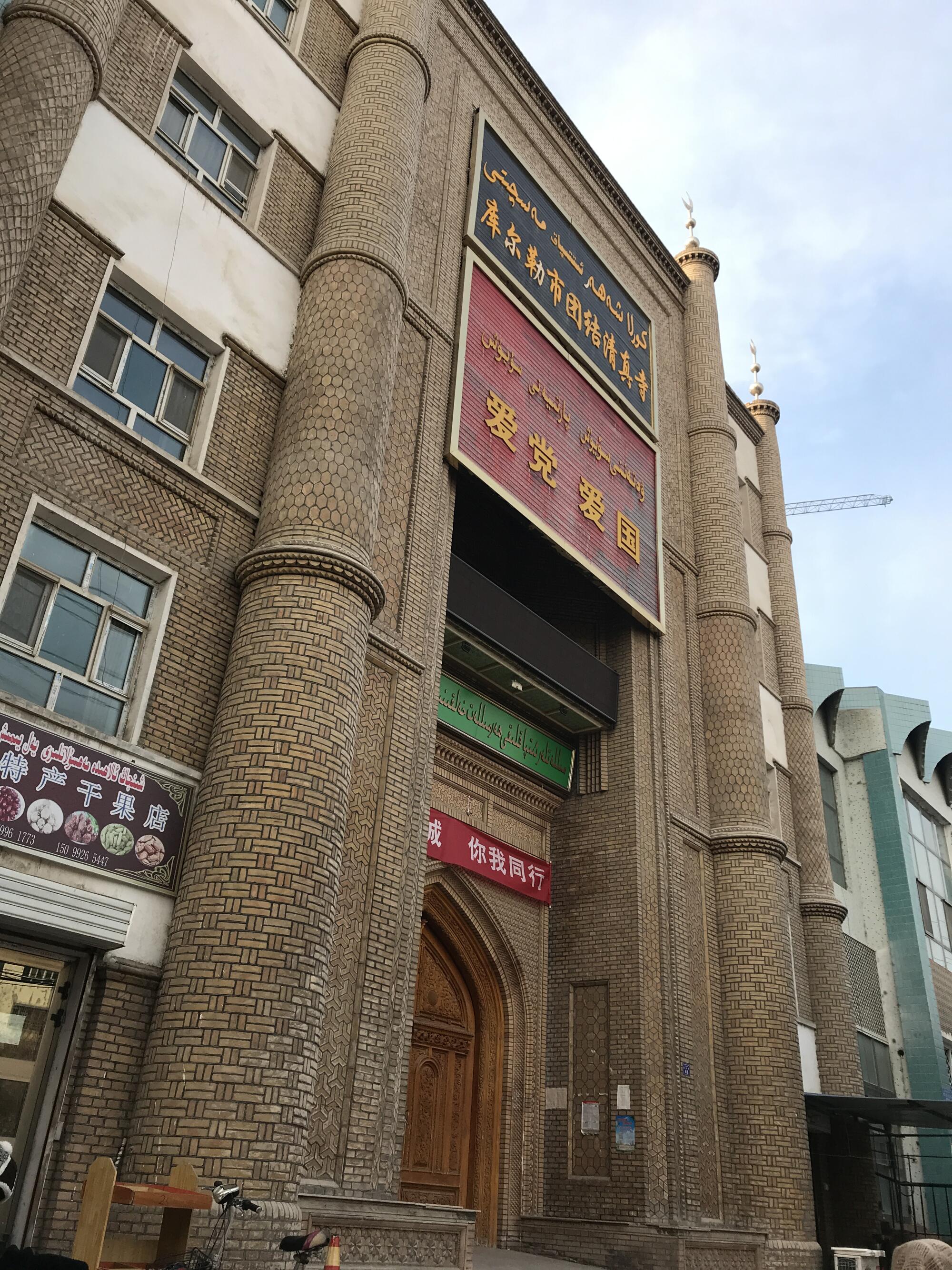
Behind these performances lies a years-long program to eradicate Uighur heritage and replace it with Han Chinese culture and obedience to the Communist Party. More than 10,000 mosques, shrines and other cultural sites have been razed, according to satellite imagery analyses. The few left standing as tourist sites have mostly had Islamic features carved off or covered up with signs declaring: “Love the Party, Love the Nation.”
Since 2016, the Chinese government has also sent more than 1 million party cadres into ethnic minorities’ homes in Xinjiang to “become family,” a program that purports to promote ethnic unity but spies on and indoctrinates minorities.
A 2018 manual posted online for such visits instructed cadres to observe Uighur homes for signs of extremism, such as receiving outside visitors, religious hangings on walls, or watching videodiscs instead of television. If they weren’t sure of the Uighurs’ honesty, they could question the children, the manual suggested: “Children don’t lie.”
Those who visited overseas websites, used unapproved apps and shared anything from such sites with others were guilty of “preparing to commit terror crimes and inciting ethnic hatred,” the manual said. Cadres should explain to families of violators: “Such activity harms national security. The party and government are punishing him to educate and save him, or else this path would lead to destruction.”
Members of the Uighur diaspora in Southern California say every one of them has a friend or family member who has been “disappeared” by Chinese police.
Dozens of cadres have also posted diaries online describing villagers obediently attending flag-raising ceremonies and sitting on plastic stools in front of the police station, where they swear allegiance to the party and vow to root out “two-faced people,” a euphemism for disloyal minorities. Many entries feature images of families waving party flags and singing patriotic songs.
In a diary entry from a village near Atush in 2017, a cadre wrote about the party secretary lecturing families of people punished for participating in unsanctioned religious activities. “Although your family members committed mistakes, the party and government have not forgotten you,” the party secretary said, then gave each family two sacks of fertilizer.
Many Uighur families were moved to tears, the cadre claimed: “The party secretary was very happy, all village cadres were very happy, the police were also happy, and the villagers were even happier.”
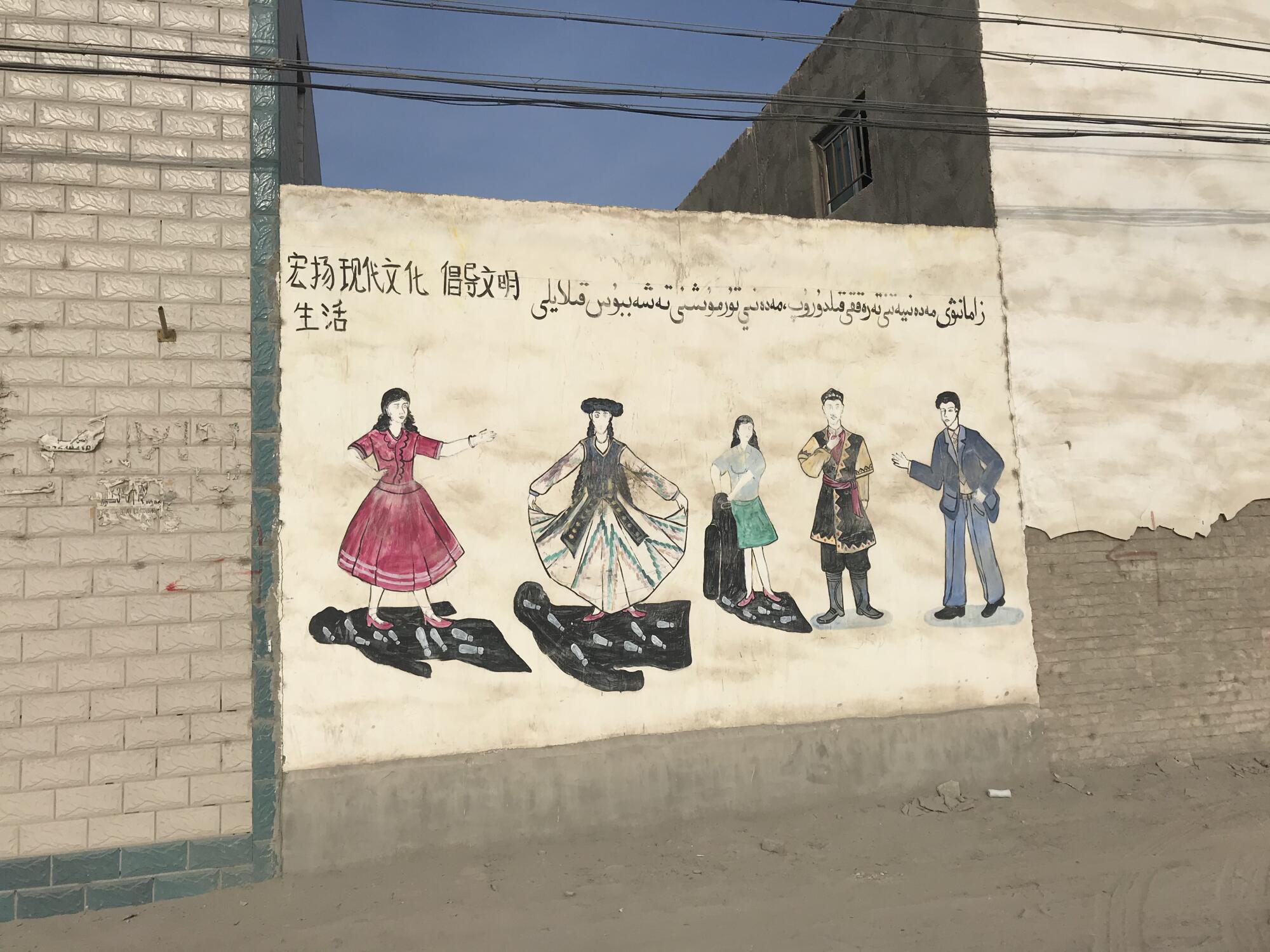
Ever lurking in the background of such “happiness” are the camps, prisons and factories.
Government documents leaked to newspapers and human rights organizations have revealed how Xinjiang authorities incarcerated minorities en masse in a system of “preventive” security. The documents have shown that the internment camps are run with commands to “teach like a school, be managed like the military, and be defended like a prison.”
The Australian Strategic Policy Institute (ASPI) has identified at least 380 suspected detention facilities in Xinjiang, based on satellite imagery and official construction documents. Some facilities were decommissioned in 2019 after Chinese authorities declared that all “students” had “graduated” from “vocational training centers.”
But new, higher-security facilities were built in 2019 and 2020 and are still being expanded, while the Uighur diaspora has reported of family members being sent from camps to prison with sentences of seven to 25 years.
In one neighborhood north of Urumqi, The Times visited a cluster of six prisons built within a two-mile radius. The floor space in their residential buildings had quadrupled since 2016, according to satellite image analysis by ASPI. They were surrounded by high concrete walls and barbed-wire fences, with guard dogs barking in the snow and military police patrolling between watchtowers.
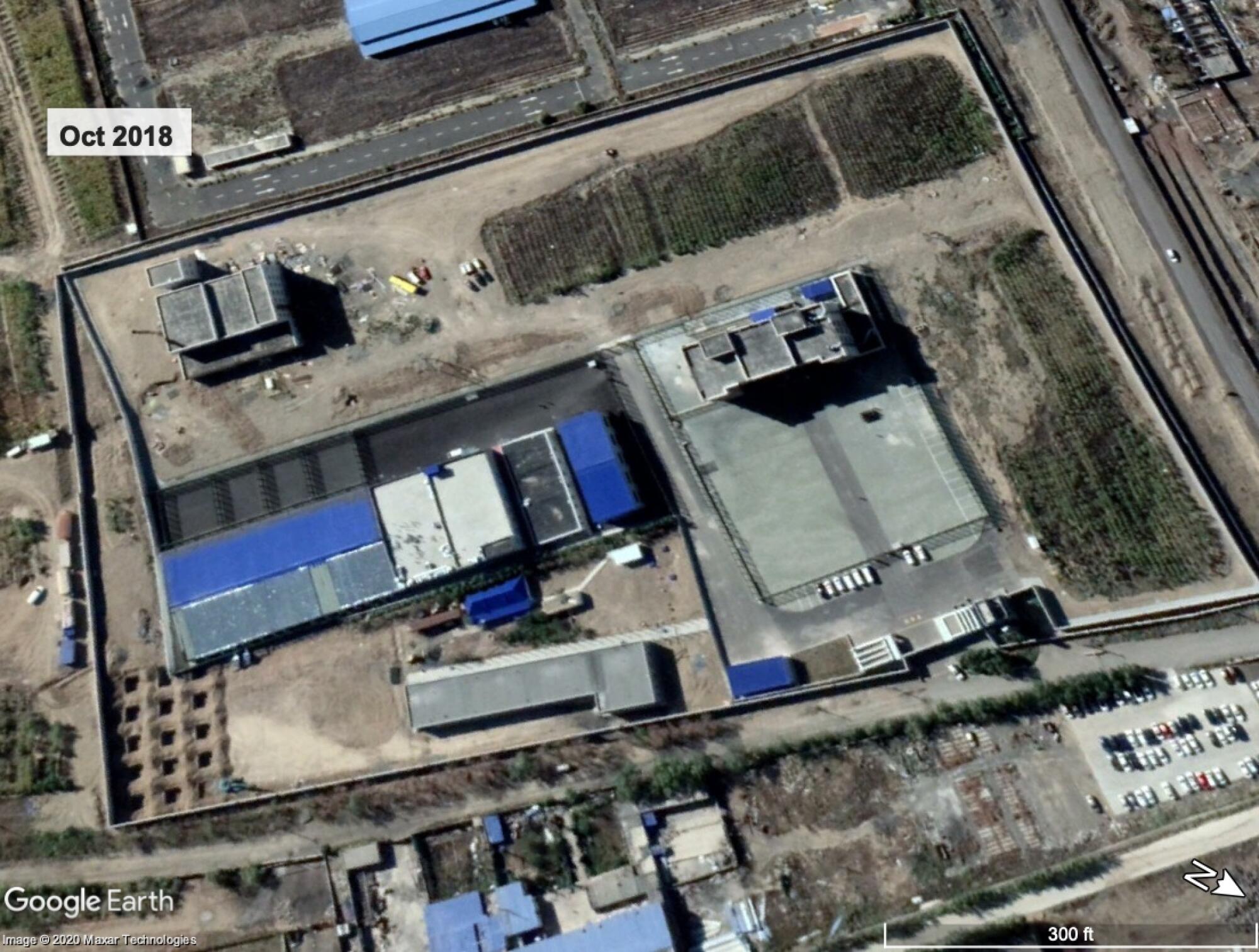
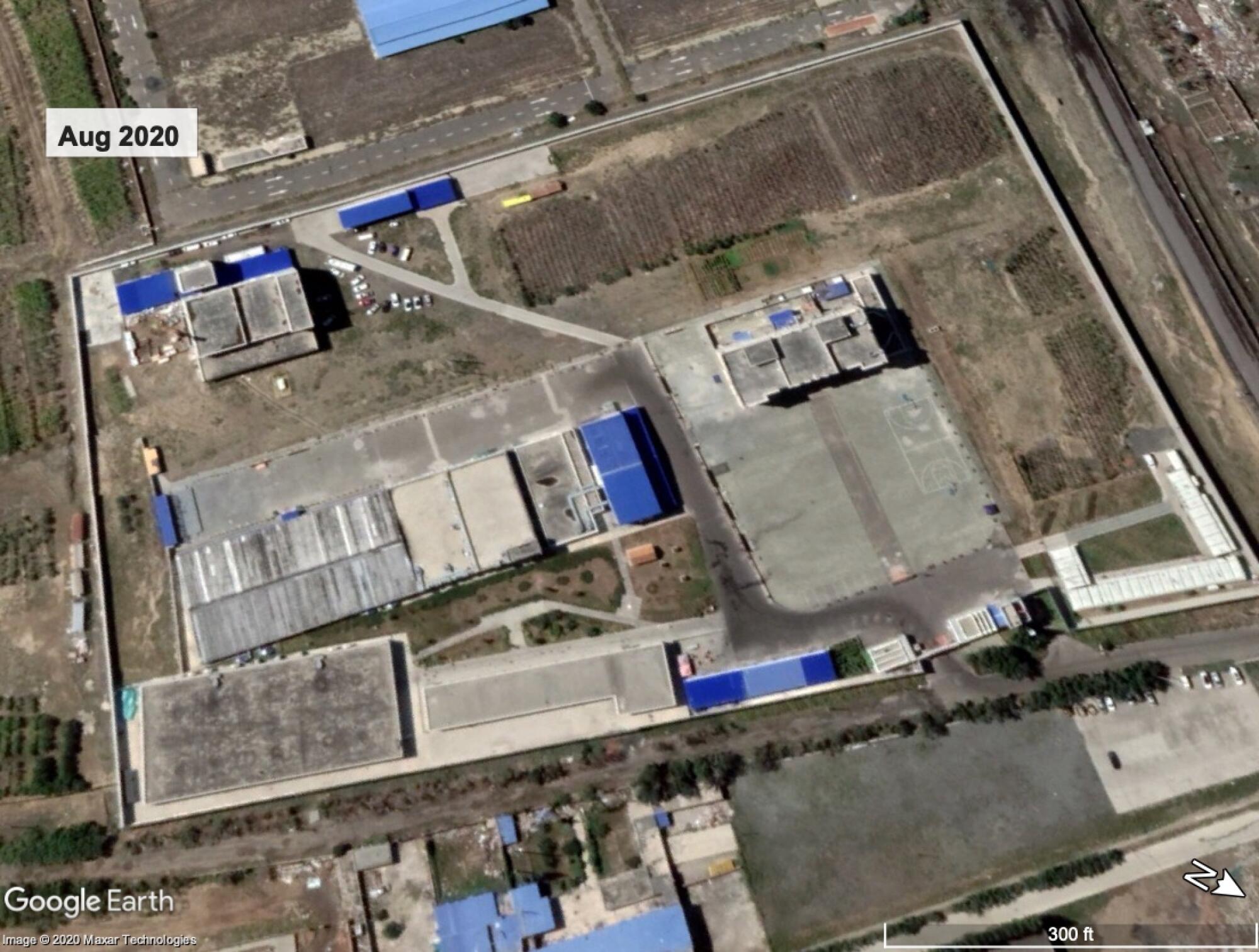
Some reeducation camps appear to have been transformed directly into labor facilities. Satellite images from 2018 of the Hongyan Clothing Park visited by The Times show that the compound had newly built features similar to those of known detention camps: internal walls and extensive wire fencing separating the buildings, with four distinct yards attached to the one block.
When The Times visited this month, the compound had been altered, with internal walls and fences removed and a basketball court added to the floor. Chinese cultural motifs were painted on a white wall around its outside.
The Times found only one company registered to the Hongyan site: Xinjiang Bailangqing Garments Ltd., established in November 2020, according to online records. Its main shareholder and legal representative, Cheng Jianghuai, is an executive of garment companies across Xinjiang. State media has lauded Cheng for his participation in “poverty alleviation” programs that place ethnic minorities in factories — a system that rights groups, academics and the U.S. government have criticized as forced labor.
Reached by telephone, Cheng said that he was the company’s legal representative, but he was not responsible for its day-to-day operations. “It’s a unit belonging to the government,” he said. Asked whether he could explain what happens at the Hongyan site, Cheng said: “I can’t explain. It’s confidential,” and hung up.
Xinjiang authorities did not respond to requests for further comment.
China’s oppression of Muslims reaches beyond Xinjiang into Pakistan. Why does it stay quiet?
One morning before sunrise, a Times reporter evaded the minders and entered the home of a prominent Uighur intellectual. Like hundreds of other Uighur scholars, poets, doctors, journalists and other intellectuals who were once honored for their preservation of Uighur culture, he has been cut off from the outside world since 2017.
He stood in a traditional embroidered green skullcap, his daughter still in pajamas beside him. A state TV broadcast played on the television behind them.
“This is what they always warn us against,” the daughter said. But they agreed to speak.
Three of the intellectual’s children had been detained in 2017, the daughter said: herself, for having made a phone call abroad, and her two brothers for having studied abroad. They were taken to separate facilities with no trial or conviction of any crime. She was held in a detention facility for more than a year, then moved to a “school” with slightly better conditions, she said.
In both, she had lived in a room of more than 10 other women. Their belongings were confiscated. They had no outside contact except one three-minute phone call to their home every two months. She was not beaten, but her brothers were. They were allowed no calls through the first year.
You could write our story. But after that, will they let us live?
— A Uighur father
Every day in the camps, they studied two books of Mandarin and Chinese laws and regulations, the daughter said. Those who spoke better Mandarin were made language teachers to the other detainees, many of whom were farmers.
For a year and a half, they lived without hope of release. Her father, weak with heart disease, was hospitalized several times while his children were gone — though he was not detained. Then, one day in 2019, they were suddenly let out.
“They all kept watching us after that,” she said. “The neighborhood committee, the officials, the public security, they came to our home every day.” Families like theirs, who once had contact with academic colleagues abroad, were under heightened scrutiny. They were warned never to speak to foreigners without the presence of officials.
Not everyone had been released from the camps, the daughter said. Some had been moved to factories, others to prisons. Those who were out didn’t need any more physical monitoring. Fear of return to the camps kept them silent.
Speaking Mandarin, his voice slow and thick, her father wondered why his and many other Uighur families were detained in the first place: “They are good people,” he said. “They did nothing wrong. Some died in those places. Why were they taken?”
Tashpolat Tiyip, former president of Xinjiang University, is reportedly sentenced to death. He was a Communist Party member and urged students to learn Mandarin: “If he’s not safe, then who is?”
Asked by The Times reporter for permission to write about their experiences, the father paused.
“You could write our story,” he said, turning to look at the reporter. “But after that, will they let us live?”
Journalists in China understand the country’s dark side, he said. “We Uighurs are not meant to live. We Uighurs should be erased from this earth.”
“My father is speaking out of anger,” his daughter said. They were glad to know the outside world was paying attention to Xinjiang and that some Uighurs abroad had been reunited with their families. “But we are all here. We have no relatives outside, no escape,” the daughter said. Many Uighurs in Xinjiang no longer think of anything beyond eating, sleeping, being together and not being in the camps.
“Tell our story, but don’t use our names,” she murmured. “Please leave. I am afraid because you are here.”
Just before the reporter left, the father stood. He grasped her hand and shook it, his back straight, his gaze steady through his tears.
This is the seventh in a series of occasional articles about the effect China’s global power is having on nations and people’s lives.
More to Read
Sign up for Essential California
The most important California stories and recommendations in your inbox every morning.
You may occasionally receive promotional content from the Los Angeles Times.
